How to Keep Food Warm Without Electricity (8 Ways)
Author: Anne Cowart | Editor: Omar Alonso
Review & Research: Jen Worst & Chris Miller
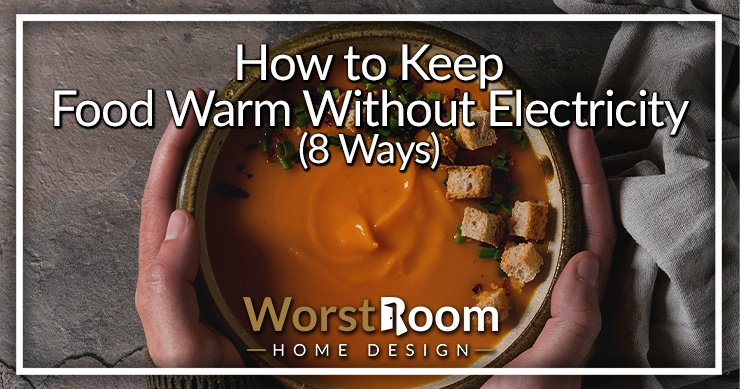
You finish cooking your meal, and suddenly, you don't have any appetite. You know you'll be hungry later, but the food will be cold by then. Now the question is how to keep food warm without electricity.
That's good news if you have to cook because you're going out to a friend's house and you have to bring it along in the car, without it getting cold. This post gives you eight methods on how to keep food hot without electricity.
Why You Need to Keep Food Warm After Cooking
When you finish cooking, the food you prepare starts to cool. As the temperature drops, it becomes a magnet for bacteria, and every minute you leave it cold outside of the refrigerator presents a food safety risk.
The FDA recommends that hot foods have a minimum internal temperature of 140 °F to avoid multiplying bacteria and causing food-borne illness. Plus, eating something fresh and warm; it just tastes better.
How to Keep Food Warm Without Electricity? – 8 Methods
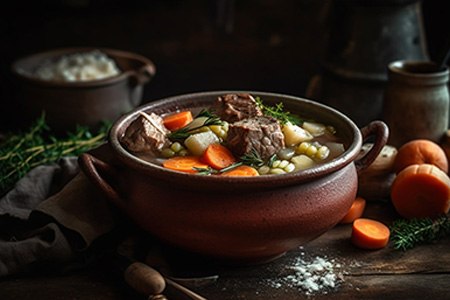
You can use several strategies to keep food warm without using an electrical appliance. From simple methods using stuff lying around the kitchen to hacks you never dreamed of being useful, we have them ready for you to peruse.
The method you use to keep food warm depends on the duration from when you finish cooking to when you eat it and whether you're transporting food to another location outside your home.
Gas Stove
A gas stove is ideal for keeping food warm if you have a blackout at home or camping. Most gas stoves run on natural gas or propane, and they're readily available for big box retailers or camping stores. If you have a gas range at home, the burners will likely work without electricity, depending on the model. However, the oven won't work, even if it's gas-powered. Still, these types of ovens can save the day due to the stovetop.
Aluminum Foil
If you're taking food to a friend's house after cooking, cover it in aluminum foil. Every home has aluminum foil; it's a kitchen essential. If you place the food on a plate and cover and seal the plate with aluminum foil, it can stay warm for up to two hours. If the power comes back on, you can even put the aluminum foil in the oven, too.
The duration of food stays warm depends on how many layers of foil you use and the density and heat of the food when you wrap it up. Aluminum reflects heat and traps the steam emanating from the food in the sealed area. For an even longer heat-holding time, we recommend wrapping the aluminum-sealed food in a towel, and you'll get an extra hour or so before it cools. The towel acts as an additional insulator, holding in the heat.
Thermal Bag
An insulated thermal bag is another option for keeping food warm. It's not the best option for traveling long distances; you can expect it to hold the heat in the food for around an hour.
Thermal bags come in various sizes, from those used by food delivery companies to some that are lunch-box-sized. The bags are lightweight and inexpensive and ideal for traveling short distances.
Chafing Dish
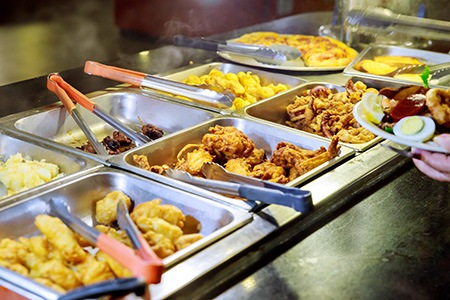
You'll see chaffing dishes used by catering companies at conferences and buffets. They usually have design and construction with stainless steel or aluminum (we already discussed how this material reflects heat). A chafing dish can hold in heat for hours and have a user-friendly operation.
The components of the chafing dish setup are the pan, serving dish, and fuel container. They're affordable to buy but usually cost more than thermal food bags. They also require positioning on a flat surface and aren't portable.
Chafing dishes can be bought from catering companies or big box grocery stores. The chafing dish keeps food warm by using a fuel burner below the dish that heats a pan filled with hot water under the serving dish. This setup ensures the food stays warm without overcooking it.
This option is great for keeping food warm at parties or family get-togethers where you finish cooking but don't want to serve right away. If you have one of these, it's a great method for how to keep food warm without electricity, though perhaps comes with the largest clean-up chore afterwards.
Thermos
Use a thermos if you have soups and other liquid meals you want to keep warm. This insulated carrier lets you take your food on the road. The thermos features double-walled construction with an insulated layer between the interior and exterior.
The insulation keeps the food hot for hours. You could prepare some soup in the morning, and it will still be warm by the afternoon. The interior chamber of the thermos is stainless steel, a fantastic conductor of heat and ideal for retaining the warmth in your food.
Cordless Slow Cooker
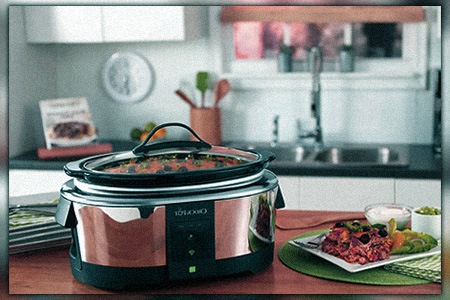
If you want to keep food warmer for longer, consider using a thermal cooker. These units are like cordless slow cookers or crock pots and offer long heating times. They're battery-operated devices, and you charge the internal battery, then disconnect it if you want a portable cooking device. Just be careful which parts of the crock pot you put in the dishwasher afterwards.
Most units have the ability to warm food, or you can set it to slow cooking mode and keep cooking the dish to finish it off on battery power. A thermal cooker is a well-insulated device; the thick insulation inside the unit's body keeps the internal heat in the cooking chamber, requiring little energy to maintain consistent temperatures.
Hot Water Bottle
You can also go to old school and use a hot water bottle to keep your food warm. The hot water bottle requires filling with boiling water, and the heat energy from the water permeates the outer casing, emanating into the room around it.
Most of us use a hot water bottle in our beds during the winter to heat it before we go to sleep. However, you can also add a hot water bottle to a thermal bag to increase its service life. Adding a hot water bottle, you should get an extra hour or two out of the heat inside the bag.
Hot water bottles feature design and construction with silicone materials, making them flexible and affordable. You can pick one up from the local big box retailer or camping store near you, and they come in a range of sizes, usually measured in liters. However, we recommend avoiding vacuum insulation models as they are less efficient at emitting heat than standard silicone models.
Cooler
Coolers aren't just for keeping things cold. You can use them as a way of keeping food warm too. Coolers feature design and construction with insulated walls, usually featuring polystyrene foam. The lid can be insulated or feature a design with thick plastic.
All insulation materials are capable of keeping things hot or cold, and the cooler is no different – so it could be a "warmer" in this case. The best course of action for long-lasting warmth is to preheat the cooler before adding the food. Fill it with hot water (not boiling water) and close the lid. Let the water sit inside the cooler for 15 to 20 minutes, and drain it. Then add your food.
Pre-warming can double the heat-holding time of the cooler. Or you can add a hot water bottle to the cooler's interior and keep it there while transporting the food. Using a cooler to carry food to a friend's house is a great idea.
Coolers come in various sizes, and we recommend getting a 25-liter model. This site is easy to preheat and has enough space to carry most meals. Coolers are inexpensive and readily available from big box retailers and camping stores.
FAQs for Keeping Food Warm Without Electricity
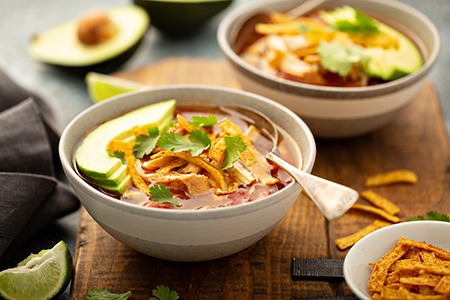
When anyone asks how to keep food warm without electricity, there is inevitably a handful of other questions that come up. Let's deal with those now.
What Is the Ideal Temperature to Keep Food Warm?
According to the FDA, you should keep your food warm at a minimum temperature of 140 °F to prevent bacteria from growing, infesting the food, and causing food-borne illness.
How Long Does Food Stay Warm Without Electricity?
After cooking, food will rapidly cool and be cold in around 20 minutes, depending on environmental conditions. Using the hacks in this post, you can keep your food warmer for longer. We have options for keeping food warm for anywhere up to 6 hours. Follow this guide on which food will remain safe for how long.
How Long Will Food Stay Warm, Wrapped in Aluminum Foil?
Typically, you can expect food that's double-wrapped in aluminum foil to stay warm for up to two hours. Wrap it in foil and double-wrap the foiled food in a towel, and you can double the heat-holding time.
Key Takeaways for How to Keep Food Hot Without Electricity
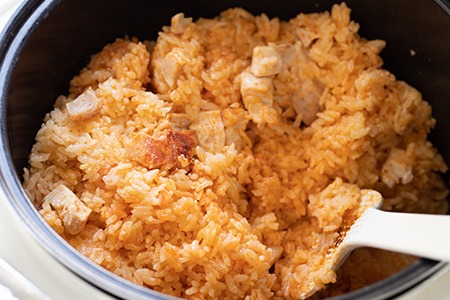
- Keeping food warm after cooking is essential to stop the spread of food-borne illnesses.
- If you let food cool, send it to the refrigerator for storage. Please don't leave it out at room temperature.
- There are a range of methods you can use to keep food warm with no electricity. Some last an hour or two, and others last up to six hours or longer.
- We like using hot water bottles and thermal bags as the best choices for transporting warm food. A preheated cooler is also a great option.
- If you have the budget, buy a thermal cooker. These battery-operated units offer the longest heating times but aren't portable.
That’s How to Keep Food Warm Without Electricity
When it comes to how to keep food warm without electricity we’ve provided eight different methods, but if I can speak personally for a moment, I would recommend simply using aluminum foil crimped and sealed tight (which will also keep the moisture locked in) or I’d drop the food in a room temperature ice chest (obviously without ice). Those would be your easiest and most effective methods, unless you have a gas powered stove or other appliance-based means of keeping the food warm.




